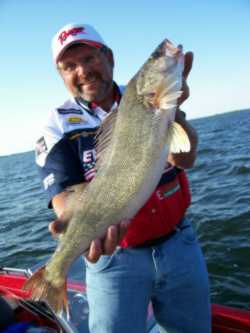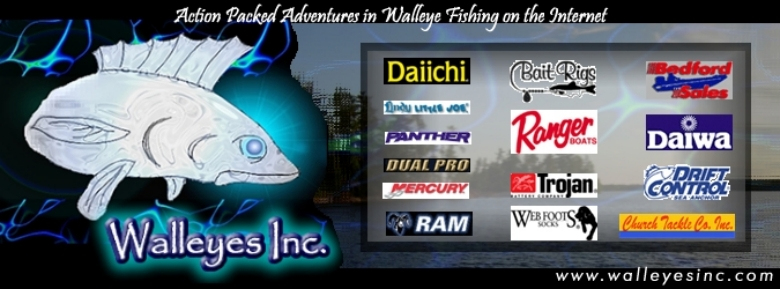| With all of the tools available now to the modern walleye
angler, one of the oldest and most effective tools for catching
walleye on rivers early in the year continues to be a good anchor.
What surprises me is how many fishing rigs don’t even
have anchors or at least anchors that can properly hold a boat
in moderate current. I spend a good amount of time each spring
anchoring on the rivers I fish and to this day, I can’t
find anything as effective as sitting on top of a good spot.
Generally, we are anchoring on current seams or some other
break. Points in the river, rock piles, wing dams and rip
rap are all potentially good breaks that will form an eddy
or current break. Early in the season, the best spots are
often close to the shoreline and shallow. We can usually see
the actual current break which looks like a ripple on the
surface unless wind is blowing hard up river. Generally, aggressive
fish are on top of the point or in front of the current break
where inactive fish may be behind or in the hole.
One of the most important and overlooked aspects of our presentation
while anchoring is the direction or angle of our retrieve.
Bass anglers are often looking for different angles or directions
they can fish cover. Walleye anglers should learn a lesson.
What we have found is that we can really fine tune our presentations
and become much more effective at pulling fish off a spot
by being conscience of the angles we are using to reach fish.
 |
Often, we may start out by anchoring directly
upstream of the current break and pitching either hair
jigs or jigs tipped with Gulp! downstream, dragging the
jigs against the current. Say this strategy catches a
few fish off the spot. Now we can often trigger a few
more fish by changing the direction or angle of our presentation.
We can easily accomplish this task by tying the anchor
rope off of different cleats, letting our more rope and
sliding across and to the side of the current break. This
position allows us to cast into and up stream with our
jigs and we than let the current sweep the jigs through
the spot. With an anchor, we can thoroughly dissect a
spot by casting several different angles cross current
and also by dragging jigs directly against the current. |
Whether we are casting and dragging or casting and letting
the current sweep the jig through the spot, plastics and hair
are extremely effective early in the season. In fact, we use
live minnows sparingly. We encourage anglers to experiment
with hair jigs and plastics. Obviously, scented plastics are
much more effective. By far, Gulp! has been the most effective
plastic for me but we also still use some Powerbait. Generally
on many of the rivers I frequent each spring, we might be
anchored in ten feet of water or less and casting into much
less water. Jig weights very but just make sure you are using
a jig heavy enough to find bottom as you tumble downstream.
Many of the really good river rats I know prefer a high-vis
mono for this style of fishing; in fact most anglers are rigged
with Berkley Sensation in the high visibility green in six
pound test. The best rod for pitching jigs is a heated debate
with many Fenwick, G Loomis and St Croix fans who all feel
they have the best rod for jigging. I won’t dispute
any of them as they all make great rods but for me, the best
jigging rod I have ever had my hands on is a Jason Mitchell
Elite Series JMS66MXF. This six and a half foot rod is so
incredibly light that I fish all day hard and never want to
set the rod down. This rod just feels good in my hand and
I fish well with the rod.
A few final notes on anchoring and pitching jigs to walleyes
relating to shallow current breaks. Big fish are almost always
shallow in the spring as soon as fish leave their wintering
holes. The fish are usually relating right to these current
breaks, you have to be right on the spot to be successful.
The fish generally want the jig moving in particular direction
or angle so be patient as you work spots. Anchoring allows
anglers to slow down the day, work one spot at a time and
work these spots well. Set out with the mindset that you are
going to work just a half dozen of your best spots in a day.
This patience and strategy can often pay dividends in the
form of several big fish.
Editors Note: Bill Ortiz is a past PWT Angler of the Year
and PWT winner
|

